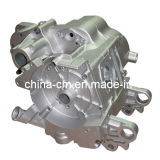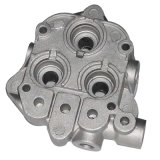| Prod Model: |
CM-HI0011 |
| Markets: |
North America,South America,Mid East,Eastern Asia,Western Europe |
| Process: |
Investment Casting+CNC Machining |
| Casting Metal: |
Cast Steel |
| Casting Form Material: |
Metal |
| Casting Form Usage Count: |
Disposable |
| Coating: |
Without |
| Casting Method: |
Lost Wax Casting |
Product Description
Descriptions:
Carbon steel castings, low alloy steel, Steel Investment Casting, Lost Wax Investment Casting, Metal Casting, Stainless Steel Casting, Duplex Steel Castings, Fully Machined Steel Castings, High Alloy Steel Castings, Low Alloy Steel Castings, industry steel casting, large steel casting, small steel casting.
Procedure of Castings
1. Pattern creation - The wax patterns are typically injection molded into a metal die and are formed as one piece. Cores may be used to form any internal features on the pattern. Several of these patterns are attached to a central wax gating system (sprue, runners, and risers), to form a tree-like assembly. The gating system forms the channels through which the molten metal will flow to the mold cavity.
Mold creation - This "pattern tree" is dipped into a slurry of fine ceramic particles, coated with more coarse particles, and then dried to form a ceramic shell around the patterns and gating system. This process is repeated until the shell is thick enough to withstand the molten metal it will encounter. The shell is then placed into an oven and the wax is melted out leaving a hollow ceramic shell that acts as a one-piece mold, hence the name "lost wax" casting.
Pouring - The mold is preheated in a furnace to approximately 1000° C (1832° F) and the molten metal is poured from a ladle into the gating system of the mold, filling the mold cavity. Pouring is typically achieved manually under the force of gravity, but other methods such as vacuum or pressure are sometimes used.
2. Cooling - After the mold has been filled, the molten metal is allowed to cool and solidify into the shape of the final casting. Cooling time depends on the thickness of the part, thickness of the mold, and the material used.
3. Casting removal - After the molten metal has cooled, the mold can be broken and the casting removed. The ceramic mold is typically broken using water jets, but several other methods exist. Once removed, the parts are separated from the gating system by either sawing or cold breaking (using liquid nitrogen).
4. Finishing - Often times, finishing operations such as grinding or sandblasting are used to smooth the part at the gates. Heat treatment is also sometimes used to harden the final part.
For detail information, please feel free to contact us.
|
Shapes : |
Thin-walled: Complex
Solid: Cylindrical
Solid: Cubic
Solid: Complex
Flat |
|
Part size: |
Weight: 0.02 to 70kgs |
|
Materials: |
Metals
Alloy Steel
Carbon Steel
Stainless Steel
Cast iron
Duplex stainless steel
Grey iron
Especial steel. |
|
Casting Surface |
Ra 6.3 ~R12.5 |
|
Machining accuracy |
IT6~IT 7 |
|
Machining Tolerance |
+/-0.001 |
Lead time
|
Within 6~7weeks |
Chaomei Machinery is a professional supplier for casting and machined part which is widely used for Automobile, Medical, earthmover, petroleum, electricity Industry.Dedicating in long-term business with foreign customers from North America and west Europe, we are exactly know what'S the customer requirement when they provide drawings and material specification.And our engineering can suggest the best process and technology to make the component or any design changing if necessary.Most of our products are exported to Canada, USA, and west Europe Germany, France, Italy, Norway, Finland, Switzerland, etc.And win good reputation among our customers





